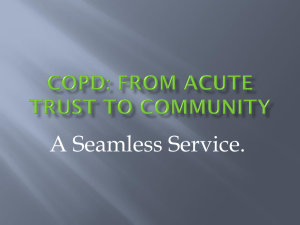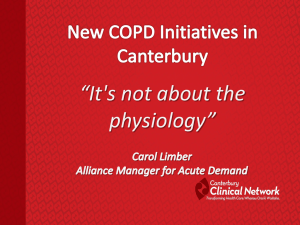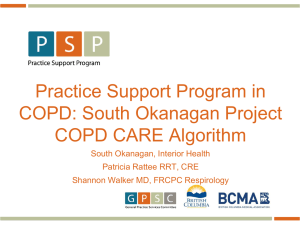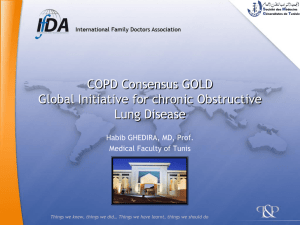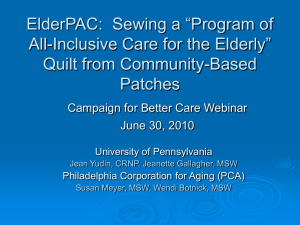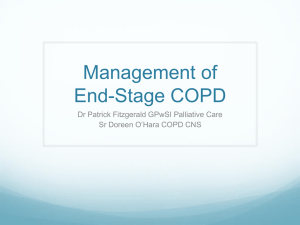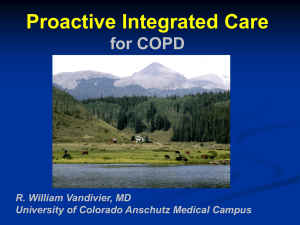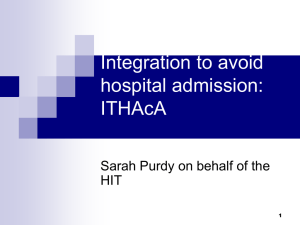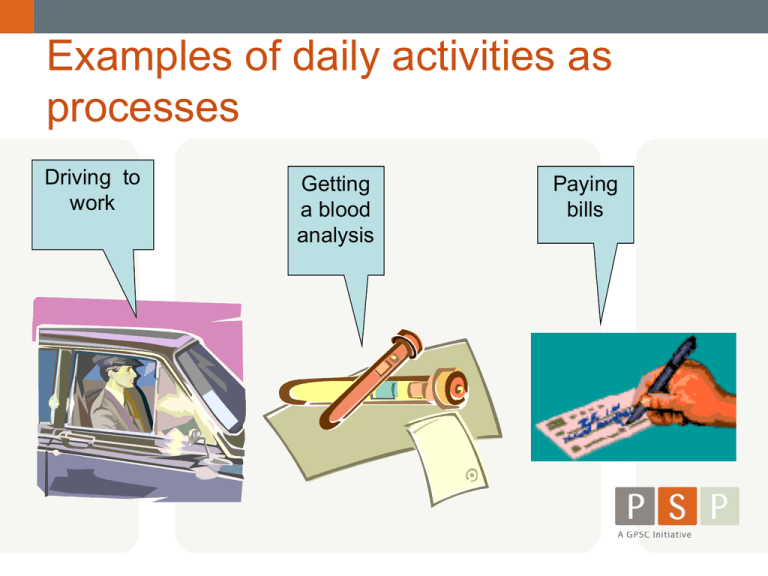
Examples of daily activities as
processes
Driving to
work
Getting
a blood
analysis
Paying
bills
Example of the process for
obtaining a spirometry
Need for
spirometry
determined
Lab
requisitions
Spirometry
Test done
Pt. called
With spirometry
date
Results
analyzed
Reports
Printed
Lab requisition
delivered to lab
Spirometry
scheduled
Reports
Delivered to Dr
Modified from Langley et al, (2009) Improvement Guide, p. 37
Steps to guide HOW to conduct
Patient Journey Mapping
Step 1: Start with
quality improvement guideposts
1. What are you trying to accomplish? (Aim)
2. How will you know change is an improvement?
(measures)
3. What changes can you make that will result in
improvement?
Aim
1. Include:
The group of patients you are considering
What your team wants to achieve
Scope
Clear numerical targets
AIM TEMPLATE:
We aim to improve _________(name the process
or topic) in _____(location) so that _________
(a numerical goal). By working on the process,
we expect ____________(list benefits). It is
important to work on this now because
________(list imperatives.) Some things we
have to keep in mind as we work are _______
(guidance & scope).
Taken from Davis, C charter template
Measures
2. Include
a balanced set of measures
o Outcome measure
o Process measure
o Balancing measure
Tests of Change
3. Include:
• Orientate participants to plan-do-study-act
short cycle changes
• After mapping:
decide on 3-5 small tests of change that will make a
big improvement for each top problem identified
Use NHS 10 high impact changes
Step 2
Preparations before mapping
1. Delegate a project champion
• Facilitation skills
• Patient journey mapping skills
• Project management skills
• Quality improvement skills
Step 2
Preparations before mapping
2. Identify the patient group to be mapped
• Share common characteristics
• Who present in relatively high volume
• Whose care could be relatively fast if you
took out all waits and delays
• Whose care could be mainly pre-scheduled
Step 2
Preparations before mapping
3. Build your team
• Everyone involved in COPD care
•
•
•
•
Target department head managers
Emphasize each participants contribution-create ownership
See Managing Human Dimensions of Change NHS
leaders guide
Invite a representative sample of patients
•
•
•
•
Can they advocate for themselves?
Will they be able to sit on health boards?
Have you considered their unique needs
See Involving Patients and Carers NHS leaders guide
Step 2 cont’d
Preparation before mapping
4. Conduct an orientation for all participants
•
•
•
•
•
Explain the why and how of mapping
Show some maps
Get team input for aim, measures & scope
Teach “5 whys”, root cause analyses
Set mapping date
Step 2 cont’d
Preparations before mapping
5. Arrange a venue (preferably off-site)
6. Get an un biased facilitator for mapping
Preferably not part of the system
Able to “square” each step with patient participants
Able to help quiet people talk and not let talkative dominate
Able to create collaborative dialogue
Collaborative Dialogue
• Assume that others have pieces of the answer
• Listening to understand
• Bring up your assumptions for inspection and
discussion
• Re-examine all points of view
• Admit that others’ thinking can improve yours
• Discover new possibilities
• Collaborative means attempting to find common
understanding
Citizens’ Dialogue on the Ontario Budget Strategy 2004-2008
Step 2 cont’d
Preparations before mapping
7. Create a mapping day agenda
•
•
•
•
•
•
•
•
•
Introductions-and group rules
Nominate a second pair of hands-documenter
Set the context-background & progress
Agree on aim for the day & mapping scope
Map the patient journey
Discuss and agree that the map is correct
Analyse the map
Orientate PDSA method to use for tests of change
Plan actions and further work
NHS leaders Guide p.36
Step 2: cont’d
Preparations before mapping
8. Gather Resources
A roll of white table cover paper
Flip chart
Coloured markers
Camera
Step 3: Creating the map
1.
2.
3.
4.
5.
6.
Cover a long portion of wall with roll paper
Draw a horizontal time axis along bottom
Define first and last step of journey (scope)
Draw every step of the process using symbols
Start mapping keep asking “what happens next?”
Guesstimate time for each step & between each
step-with different color markers
7. Square with patients “is this what happens”
8. Record who does what to patient in different
marker
9. * star top problems as you go along
Symbols used in mapping
Oval – demonstrates the start
and end of the process
Box – demonstrates a tasks or
activity of the process
Diamond – demonstrates a
decision is required
Arrow - demonstrates the
direction or flow of the
process
Example
(Time Axis:): 1 day
...
3 months....
6 months...1 year....etc.
Tips
•
•
•
•
•
•
•
Use different color markers to differentiate process
from problems
Variations? Record what happens 80% of the time
You can’t resolve issues in 5 minutes? parking lot
Map what is happening – not what should be
Focus on what happens to the patient don’t get sidetracked by what happens to a referral form
Focus on mapping the journey not solutions
Use the map to improve the journey never to direct the
journey
Our
map
patient
patient
Quesnel’s Map Transposed
STUDY
Diagnosis:
A serious case of Maze Madness!
Heart
Attack
Journey
with
Chronic
Disease
Step 4: Analyse the map
Work directly on the map with different color
markers
•
•
•
•
•
•
•
•
Note approximate times at each step (task times )
Note approximate time between each step (wait time)
What are the (bottlenecks/constraint) causing the wait?
• unavailability of equipment or provider
Where does the patient experience a wait?
Note time from first to last step on time axis
Count how many steps there are for the patient
Note which activities add value? which don’t?
Use “5 whys” for top problems
Step 4: Analyse the map
• Note Bottlenecks
“Bottlenecks are part of the system where patient flow
is obstructed, causing waits and delays”
Map in more detail those parts of the process where
there are particular waits and delays, these are often
parallel
processes…”
(NHS, 2005, p.19,39)
Photo taken from Garrett, D.V., 2007
Parallel process demonstrated
in a referral letter
GP tells
patient
they need
a hosp.
appt
GP
dictates
referral
letter
• Mapping, analyzing and improving
parallel processes will deliver great
benefits
Patient
waits
Patient
receives
appt
• Parallel processes cause delays for
patients and frustration for staff
Hospital
appointment
clerk
posts
letter to
patient
• Map the parallel process alongside,
but separate from the patient
process (see p. 20 in NHS process mapping)
Step 4: Analyse the map
• Note how often there are “hand-offs”
Up to 50% of steps involve a “hand-off” (NHS)
90% of errors, duplication, delays in a journey occur
at the point when the patient or paper work is handed
from one person, department or organization to
another (NHS)
Step 4: Analyze (cont’d)
Other Questions to Ask:
1.
2.
3.
4.
Is the patient getting the most appropriate care?
Is the most appropriate person giving the care?
Is the care being given at the most appropriate time?
Is the care being given in the most ideal place?
Step 5: Follow-up
• Create a pictorial
• Distribute pictorial to participants and those
unable to attend for comments and corrections
• Confirm top problems with more patients
through surveys
Step 6: Coach Teams to Make High Impact
Changes
• Will the changes address top problems?
• Will one change affect another part of the
system?
• Use PDSA format to test change
• Consider 10 High Impact Change
http://www.ogc.gov.uk/documents/Health_High_Impact_Ch
anges.pdf
NHS - 10 High Impact Changes
Three changes to start with
Bottlenecks
Patient flow
Redesign/extend roles
Access to tests
Effective follow-up
Grouping patients with similar needs
Systematic care for people
with chronic conditions
Reduce steps
Reduce bottlenecks/waits
Redesign/extend roles
Share your maps
Powerful for steering through political
arenas
Senior administrators
Doctors
Health Authorities
Practice Support Program
Cramp, G.J, (2006)
Step 4: Celebrate
Gather the
team to
celebrate and
show summary
of findings
Thank-you to all the people who
taught me the most about
mapping:
Judy Huska who told me “you have to do this”
PHSA who taught me, Irene Kopetski who was
project manager, the 5 patients and the
Quesnel Mapping Team
References
•
•
•
•
•
•
•
Citizens’ Dialogue on the Ontario Budget Strategy 2004-2008
Davis, C (n.d.) Charter Template retrieved Feb 28th from:
http://www.impactbc.ca/sites/default/files/resource/n158_ibc_improvement_
charter_template_2009.doc
Langley G. J., Moen R.D., Nolan K.M., et al (2009), The Improvement
Guide.
NHS (2004) High Impact Changes
http://www.ogc.gov.uk/documents/Health_High_Impact_Changes.pdf
NHS (2005) Improvement Leaders Guide: Process mapping analyses and
redesign
NHS (2005) Managing Human Dimensions of Change retrieved Feb 28th
from:
http://www.institute.nhs.uk/index.php?option=com_joomcart&Itemid=194&m
ain_page=document_product_info&cPath=65&products_id=305
NHS (2005) Involving Patient and Carers. Retrieved Feb 28th from:
http://www.institute.nhs.uk/index.php?option=com_joomcart&Itemid=194&m
ain_page=document_product_info&cPath=65&products_id=305
Lunch
37
Smoking Cessation
Dr. Fred Bass
38
Overview
• Strategy in clinical tobacco intervention
• The results of a recent pilot in which front-office
personnel took the lead in clinical tobacco
intervention (CTI)
• Checklists and tools you can use for clinical
tobacco intervention
• QuitNow services to help your patients stop
smoking
39
Strategies: Clinical tobacco intervention
• Tobacco smoking a chronic condition; relapse is
the rule!
• Clinical tobacco intervention is vital for COPD
patients; it is under-performed!
• A systematic, team-based approach combined
with medication and brief counseling is highly
effective
• New ways of using stop-smoking medication are
summarized in Alligator article
40
ImpactBC’s Health Coordinator Pilot 2008-10
• Recruited, trained, supported one front-office staff
person in 6 practices
• Role: help practice identify, assist and follow-up
all smoking patients
• Target: tobacco and three related risks—physical
inactivity, at-risk alcohol use, depression—and
charting all work
• For 8hrs/week HCs implemented the “5 A’s” of
brief intervention—Ask, Assess, Advise, Assist
and Arrange follow-up.
41
Results, Health Coordinator Pilot 2008-10
Maneuver
N smokers =
Chart-reminder
Advised to stop
Self-mgmt (incl. Rx)
Quit date
Referral
Follow-up date
Baseline
Follow-up
332
288
20%
34%
14%
5%
6%
7%
94%
79%
57%
11%
11%
42%
p
<.001
<.001
<.001
<.02
<.04
<.001
42
Checklists
• Practice
• Clinician
• Patient
Tools
• BCMJ article: Training the inner alligator
• Clinical Tobacco Intervention Options
• Smoker’s Guide (for patients)
43
44
Recap
• Strategy in clinical tobacco intervention
• The results of a recent pilot in which front-office
personnel took the lead in clinical tobacco
intervention (CTI)
• Checklists and tools you can use for clinical
tobacco intervention
• QuitNow services to help your patients stop
smoking
45
Action plan: Supporting smoking cessation with
patients
• Use the Practice Checklist to identify areas to test
• Use the Patient Checklist
• Train MOA to support smoking cessation in GP
office
• Consultation and support available from
ImpactBC
46
Developing an Office Approach
Dr. Chris Rauscher
47
Office re-design for proactive shared care
• Need to understand work flow and processes as
they exist and improve --> MOA is the expert
• CDM Office System:
Registry
Clinical tool for care management and
monitoring (e.g. Flow sheet; Actionexacerbation plan)
Recall
Analysis: Run charts
48
Office re-design for proactive shared care
• Shared Care
oCommunication
oReferral Consultation
oNew ways of working - e.g. telephone
oHandoffs: Discharge, Re-Referrals
49
The patient registry
• A list of all patients with a particular condition
e.g. Diabetes, COPD
• Based on registry, can set up system to organize
care and monitor patients’ progress (e.g. using
flow sheets)
• Can recall patients per the patient registry
50
Identify eligible patients-interim registry
A.
Categories
1. Case-finding-New patients per guideline-Simple
spirometry
2. Case-finding-Dx COPD-no spirometry – simple
spirometry /Diagnostic spirometry
3. Confirmed COPD (spirometry positive)
B. Methodology to Identify Those Dx with COPD (#2 and 3
above):
1. Billing software (COPD Code: XX)
2. Paper chart review
3. EMR
4. Physician Profile Analysis Report
51
Identify eligible patients-final registry-confirmed
COPD
1. New patients with Dx confirmed by spirometry
(Dx code: 496)
2. Dx COPD, no initial spirometry, Dx now
confirmed with spirometry
3. Dx COPD, had confirmatory spirometry
52
Physician profile analysis
•
•
•
•
•
•
Secure and confidential report
Practice demographics
Complexity of patient population
Identifies potential gaps in care
Comparison to BC patients as a whole
Highlights your chronic disease patients
Diabetes, Hypertension, CHF, COPD, kidney disease
53
Other Registry Components
For Shared Care-COPD
• Besides List of Patients Dx with COPD
• Smoking Cessation-Advice, Stopped
• Exacerbation Plan- Discussed, In Use
54
Action plan: Developing relationships and care
plans amongst family physicians, specialists,
patients, and community services
• Exacerbation planning
• Self-management support training
• Track how many patient have a self-management
plan
• Track how many patient have an exacerbation
plan
55
Exacerbation Plan in
Self-Management Context
Dr. Chris Rauscher
56
Objectives
• Self-management support-a brief summary
• Focus on exacerbation (action-flare up) plans
within a self-management context
• Implementing an exacerbation plan-Table
discussion
57
What is self-management?
“The individual’s ability to manage the symptoms,
treatment, physical, and social consequences and
lifestyle changes inherent in living with a chronic
condition.”
“Confidence to deal with medical management,
role, and emotional management”
Motivation (importance), confidence, skills
58
SMS: What is it?
• “Self-Management Support is the assistance
caregivers give patients and their self-defined
circle of support so patients can manage their
conditions on a day-to-day basis and develop the
confidence to sustain healthy behaviors for a
lifetime.”
• Increase skills and confidence in managing
• Goal setting, problem solving support,
follow-up
59
60
Confidence -To achieve this goal, the training
should teach people:
• Ways to access the information they seek;
• Ways to ensure they are proficient in carrying out
both medically-related behaviours (e.g., using an
inhaler) and non-medically related behaviours (e.g.,
interacting with one’s doctor, exercising);
• Ways to enhance their levels of confidence (i.e.,
perceived self-efficacy) in their ability to engage in
these behaviours; and
• Ways to ensure they are proficient in problem-solving
61
Information giving
Problems:
• Patient doesn’t get the info he/she wants
• Patient doesn’t understand the information
• Patient gets overwhelmed with information
62
Ask-Tell-Ask and closing the loop
• Provide information in small portions
• Closing the loop: Give information, assess
understanding
• Ask-tell-ask: Provide information, ask-is there
anything more you would like to know, telladditional information, ask- anything further?
• Can also close the loop within ask-tell-ask
63
Action Planning over time
• Reviewing goals and action plans
• Teaching problem-solving skills
• Teaching of self-monitoring skills
• Motivational Interviewing
• Suggesting and linking patient to community
resources (e.g., the community CDSMP)
64
Health professionals recommendations-context
• Patient’s life context and stage-Broad
• Professional perspective-more focused and point
in time - e.g. Exacerbation plan
• Professional practice approach relates to ‘tasks’
for medical management
• How to bring the perspectives together for a
patient “action plan”-general and specificconfidence >7/10
• Work over time, know your patient
65
Exacerbation Plan
(COPD Flare up
Action Plan)
66
Exacerbation Plan – What are we asking of the
patients?
• Understand and accept that they have
exacerbations (or even COPD) that need to be
and can be prevented/managed
• Contract between patient and provider
• Monitoring triggers-personal health,
environmental
• Recognizing symptoms
• Taking specific actions-many
67
Exacerbation Plans in Self-Mgt Context –
Table discussions
• Given all the things patients have to deal with,
how do you support patients to see the
importance of working with an exacerbation
plan?
• How do you increase the confidence level of
patients that they can follow the plan?
• How do you do follow-up and what do you do?
• How do the various providers work together on
this with the patient?
68
Avoidable ED Visits
Cheryl Rivard
69
Participating organizations
• BC Medical Association
• BC Ministry of Health Services – Primary Health Care Branch
• Bi-partite Committees:
General Practice Services Committee
Shared Care Committee
Specialist Services Committee
• Vancouver Coastal Health Authority
Lions’ Gate Hospital
Primary Health Care
Community Care
• BC Lung Association
• Public Health
• Primary Health Care Council (5 regional and 1 provincial health
authority)
• Impact BC
• Local Family Physicians
70
Institute for Healthcare Improvement
prototype
Reducing Avoidable Emergency Department Visits
Initiative
• Identify populations that have a high utilization of
the ED
• Test inventions
• Learn from others
• Triple Aim
71
Aim statement
To reduce avoidable ED visits at Lions Gate
Hospital by 5%, by identifying the reasons that
patients choose to visit the ED.
To link patients with supports in the community
thus preventing first or repeat time visits to the
ED.
72
Patient interviews
5 Why document
BC Team Partners
Avoidable ED Use Prototyping
Interview # _________ Patient ID #____________
Date of Interview:
____________
Interviewer Initials: ____________
Date of ER visit: ___________________
Discharged:
Dx at presentation: ________________
Admitted:
1. How did you decide you had a problem:
2. How did you decide you needed to get help?
3. How did you decide you needed to come to the ER:
4. Do you have a GP?
Yes
No
5. If yes, how did your GP help in your decision to come to the ER today?
73
The patient stories
8 Themes:
Access to GP
Available Support Services
Patient Education about condition
Social Supports
Using action plans
Linkages
Responsive system when a patient starts to
deteriorate
Transition from ER to Community
74
GP interviews using the 5 whys
In answering the following questions, think about your last
patient with COPD that ended up in the Emergency Dept?
1. What happened?
2. How did you receive notification from ED? Was it timely? Did it have
all the information that you needed? If not, what was the problem?
3. Do you create exacerbation action plans for your patients with
COPD? Do you use any other Action Plans?
4. What COPD and/or other chronic disease resources and programs
are you familiar with? Do you feel comfortable accessing them?
5. Is there anything else you would like us to know about how to
prevent avoidable ED visits for your patients with COPD? For other
patients?
75
2nd Intervention: Referral from ED
During one shift at the ED, have the staff (Dr. and Nurses)
identify patients with COPD who would be appropriate for a
referral to the BREATH Program coordinator
• Referrals sent from emergency department to COPD educator
via the Integrated Referral form which is faxed to the Chronic
Disease Services fax number and then distributed to other
programs including COPD educator.
• While it was agreed that if this could be part of the doctor's
orders in emergency, it might work better for doctors if it was
recognized that the electronic system would take too long to
adapt. Team members agreed that the person doing the
referrals would be the nurse associated with iCare.
76
Intervention – Inform GP office
Aim: to develop a process to inform GP’s that an
exacerbation plan has been created with an
educator at LGH.
Chronic Disease Program to create a form that can
be faxed to the GP office.
This form will include:
• explanation of why the patient was seen,
• a copy of the exacerbation plan
• details to complete the plan i.e. Medication.
77
78
What did we learn?
• Ask your patients Why?
• Make sure all stakeholders are at the table
• Need to work together to identify the gaps and
find solutions
• Team approach to the treating a patient
• Share information
• Find a way to measure impact on the system
• Learned from others
79
What can you do in your office?
•
•
•
•
Ask your patients
Identify any areas of support required
Add to the patients team if needed
Talk to colleagues and find out what can be
accomplished
80
Action plan: Avoidable ED visits
• Try the 5 whys methodology and work with your
local hospital
81
Break
82
Evaluation
Dr. Marcus Hollander, Dr. Helena Kadlec
83
Roles of an evaluation
Obvious –
Tell us what you thought of all this
Not so obvious –
Tracking changes over time
Reporting to the GPSC Committee and the Ministry
accountability and future funding
Publish results spreading the word; national and
international impact of these efforts
Our Approach
Prototyping a New PSP Learning Module
Session #1
Action Period
Prototype
Participants:
Pre-Session
(Baseline) Survey
Everyone in
attendance:
Session #1 Survey
** TODAY **
Session #2
Prototype
Participants:
Post-AP Survey
Module
Roll Out
Train-the-Trainers
Everyone in
attendance:
Session #2 Survey
Our evaluation today
• There are several different groups of participants
at this session
• Each has a different perspective and a different
role to play here
• Please read the instructions in the Introduction
and at the beginning of each section to see if
you need to respond.
Advanced Care Planning
Dr. Chris Rauscher
87
Advance care planning – healthcare
A process, over time, (can be supported by a tool”My Voice”) to:
• Include the patient and family in the shared care
process.
• Provide information for the patient/family to make
informed decisions throughout trajectory.
• Discuss, document, and review goals of care at
various transitions.
• Plan for acute episodic and crisis events, declining
function, and terminal phase management.
88
Who makes your healthcare decisions?
1.
2.
3.
4.
Capable adult (19 yrs).
Committee of person (court ordered).
Representative (representative agreement).
Temporary Substitute Decision Maker* (TSDM).
a) Spouse (common law, including same sex)
b) Adult children (equally ranked)
c) Parent (equally ranked)
d) Brother or sister (equally ranked)
e) Another relative by birth or adoption
f) Another person appointed by PGT
*Capable, 19 years or older, no conflict, contact within 12 months,
agrees to decide based on your wishes
89
When to hold ACP conversations
• Initiate in patient history-patient values and wishes
• Annual physicals for all adults: “I talk with all my patients
about this and we talked a little about this last year…”
• As part of chronic disease discussions: "This particular
illness can have a fairly predictable course…here are
some things you need to think about ahead of time…"
• Following emergency department/hospital admissions:
“I understand you have been in the hospital. What did the
doctors say?”
90
Patient wishes
• An Advance Care Plan ensures that the patient's
wishes would be listened to no matter who is
present.
• http://www.fraserhealth.ca/media/MyVoiceWorkb
ookENG.pdf
91
Action plan: Advanced care planning
• Initiate the ACP conversation with COPD patients
as part of their chronic disease consultation
92
Action Planning
John Lester
93
Prototype aim
To create a system of care that improves
the quality of care and experience for
patients at risk for and living with COPD
Prototyping is to start with COPD and can expand to other conditions
94
How will we achieve this aim?
• Identifying early patients who have COPD using a
case-finding approach
• Developing relationships and care plans amongst
family physicians, specialists, patients, and
community services
• Implementing more standardized referral and
consult letters, and improving relationships, hand
offs and communication between GPs and
specialists
• Improving the management of COPD by
putting the GPAC guidelines into practice
95
How will we achieve this aim?
• Supporting patients to quit smoking
• Enhancing patient self-management skills to
manage their condition
• Referring patients to appropriate community
services and resources
• Improving the patient experience with the system
of care
96
Three fundamental questions
1. What are we trying to accomplish?
Aim statement
2. How will we know that a change is
an improvement?
Measures
3. What changes can we make that will result in
an improvement?
Ideas and changes
97
Why use the Model for Improvement ?
•
•
•
•
•
•
Facilitates teamwork
Provides a framework
Encourages planning based on theory
Emphasizes & encourages iterative learning
Allows plans to adapt as learning occurs
Empowers people to take action
98
The PDSA cycle
Act
Plan
Study
Do
From: The Improvement Guide 2nd Ed. Langley GJ, Moen RD,
Nolan KM, Nolan TW, Norman CL, Provost LP, page 447:
Jossey-Bass, San Francisco, 2009.
99
Action period planning – team activity
• With your team (e.g. respirologist, GP, MOA,
RT…), discuss what changes you will test in the
action period
• Develop your first Plan, Do, Study, Act cycle and
write out your action details
• Be prepared to share your plan with the group
• You have :45 minutes for this activity
100
Some things you might try
•
•
•
•
•
Case finding
Populating your COPD registry
Developing scripts for encounters with patients
Improving the referral system for COPD patients
Building self-management support into your
COPD appointments
• Linking with Home and Community Care
• Applying clinical tobacco intervention techniques
101
Share with the larger group
• What will you do when you get back to your
community?
• Who will be involved?
• When will you start?
102
Next steps
Dr. Gordon Hoag
103
Next steps
• Action Period activities
• Support Calls, from 12 – 1 pm:
•
•
•
•
•
•
•
•
Thursday, March 24
Thursday, April 21
Thursday, May 26
Listserv discussion, information
Prototype session 2 – June 16, 2011
Evaluation form
CME Credits
Payment forms
Training material will be available at
http://www.gpscbc.ca/psp/systemofcare
104
Thank you!
105

